Comparative Analysis: Red Bull and Lucozade Marketing Mix Strategies
VerifiedAdded on 2023/01/12
|8
|2079
|80
Report
AI Summary
This report provides a comparative analysis of the marketing strategies employed by Red Bull and Lucozade, two prominent players in the energy drink market. The report begins with an executive summary and an introduction to the principles of marketing, emphasizing the importance of understanding customer needs. The core of the report focuses on findings, meticulously examining the target markets of both companies, with Red Bull primarily targeting young adults aged 18-35 and Lucozade targeting teens and young adults aged 15-30. The analysis then delves into the marketing mix (4Ps), comparing their product offerings, pricing strategies, distribution channels (place), and promotional activities. Red Bull is shown to focus on carbonated energy drinks with various flavors and extensive online and offline presence, while Lucozade offers glucose-based energy drinks with a focus on health-conscious consumers. The report concludes by summarizing the key findings and emphasizing the importance of marketing strategies in gaining market share. References to academic sources are included to support the analysis.
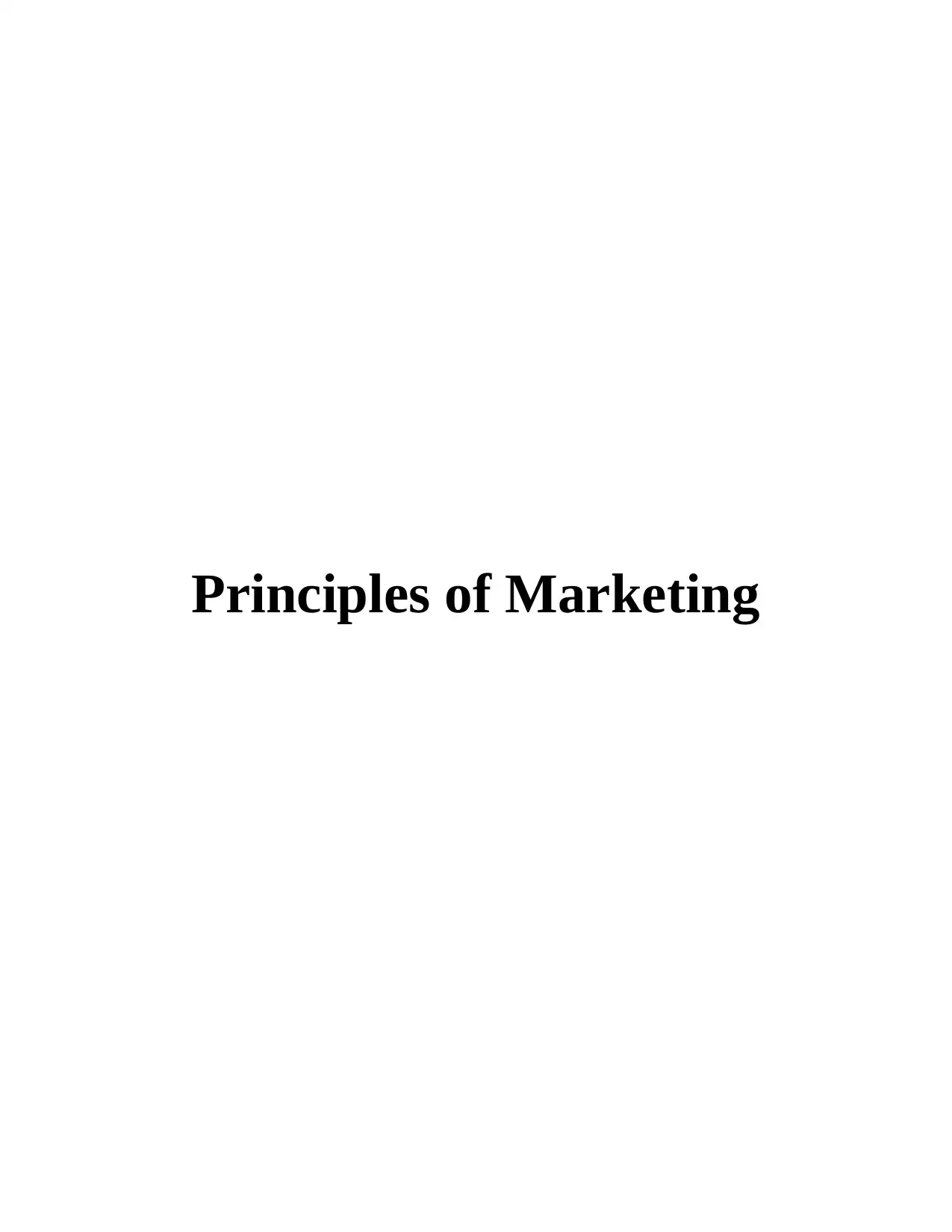
Principles of Marketing
Paraphrase This Document
Need a fresh take? Get an instant paraphrase of this document with our AI Paraphraser
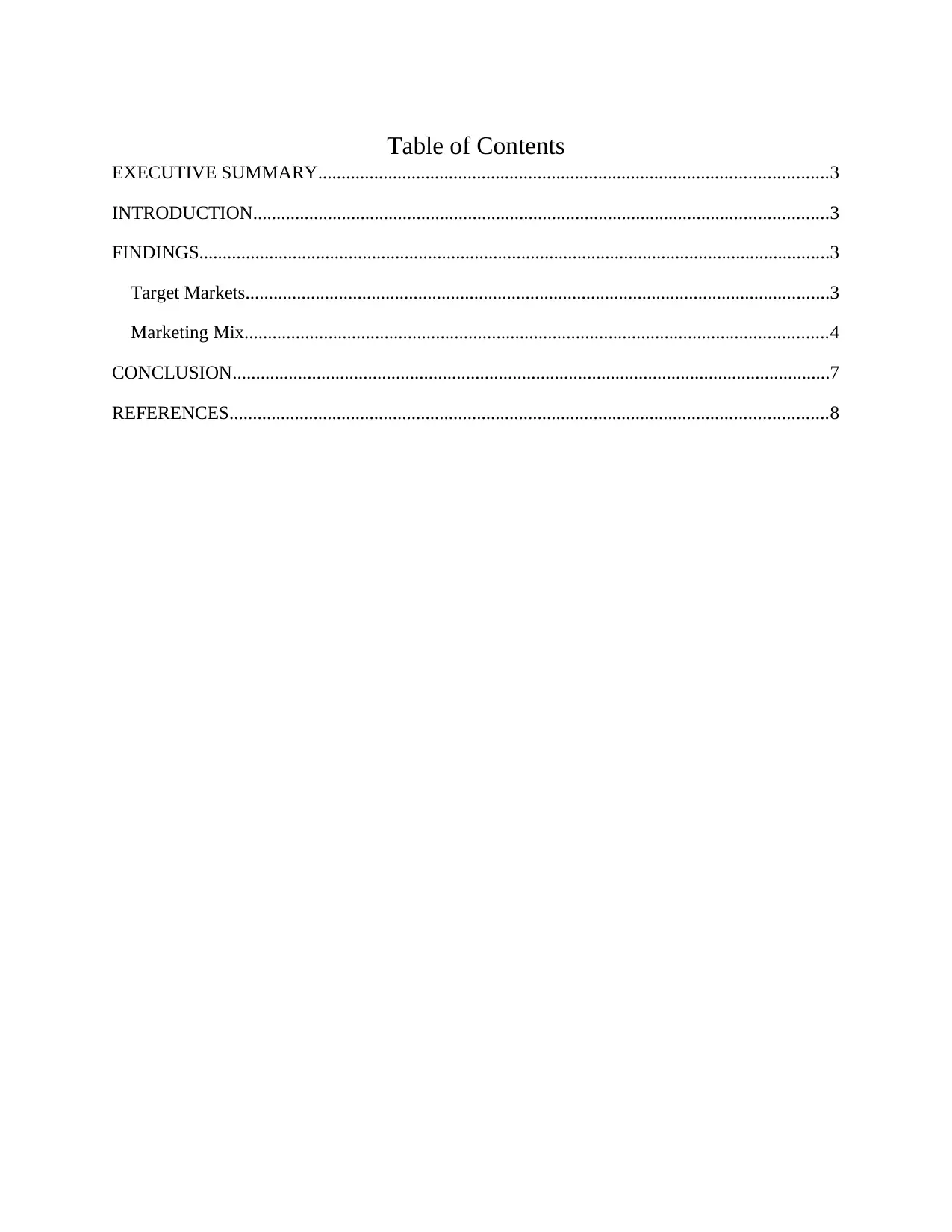
Table of Contents
EXECUTIVE SUMMARY.............................................................................................................3
INTRODUCTION...........................................................................................................................3
FINDINGS.......................................................................................................................................3
Target Markets.............................................................................................................................3
Marketing Mix.............................................................................................................................4
CONCLUSION................................................................................................................................7
REFERENCES................................................................................................................................8
EXECUTIVE SUMMARY.............................................................................................................3
INTRODUCTION...........................................................................................................................3
FINDINGS.......................................................................................................................................3
Target Markets.............................................................................................................................3
Marketing Mix.............................................................................................................................4
CONCLUSION................................................................................................................................7
REFERENCES................................................................................................................................8
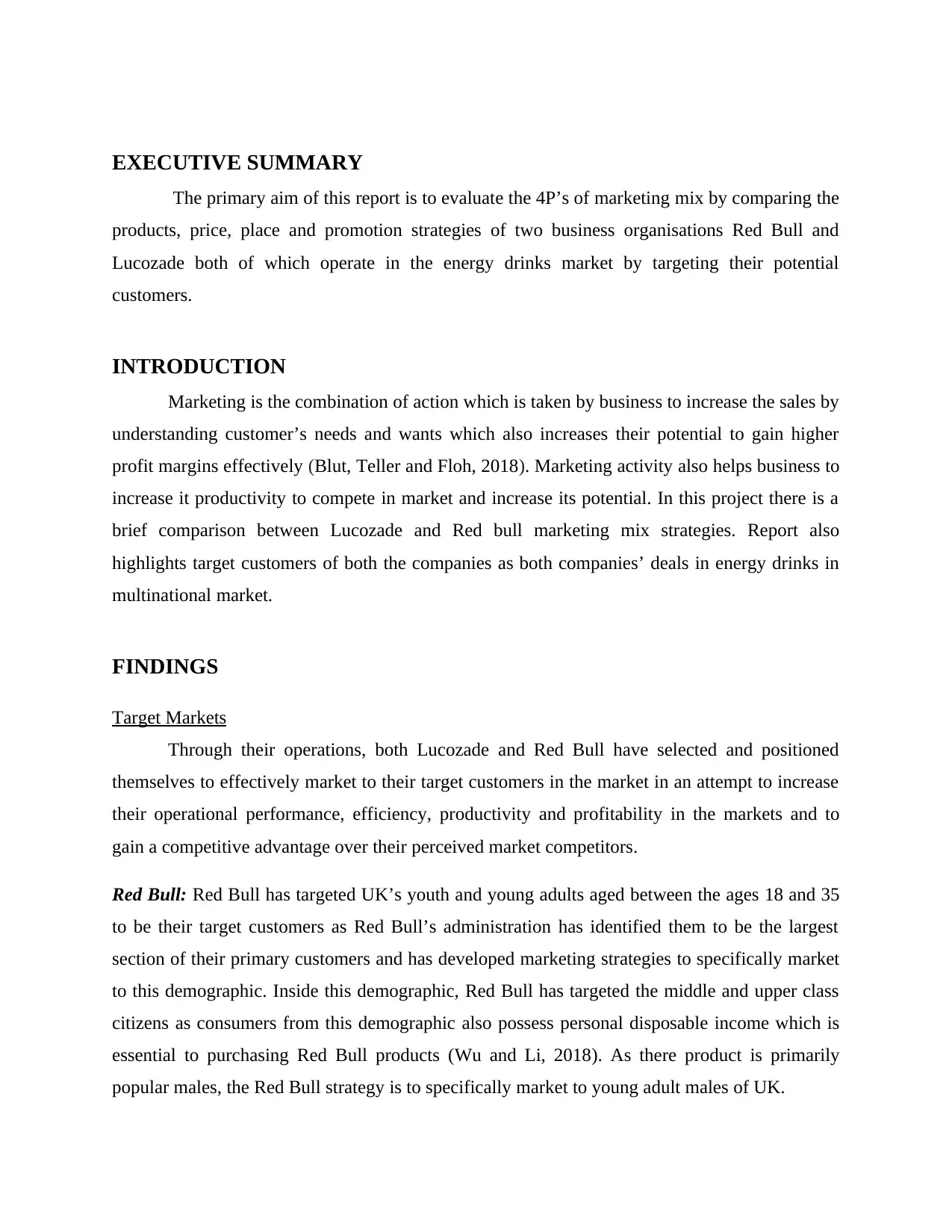
EXECUTIVE SUMMARY
The primary aim of this report is to evaluate the 4P’s of marketing mix by comparing the
products, price, place and promotion strategies of two business organisations Red Bull and
Lucozade both of which operate in the energy drinks market by targeting their potential
customers.
INTRODUCTION
Marketing is the combination of action which is taken by business to increase the sales by
understanding customer’s needs and wants which also increases their potential to gain higher
profit margins effectively (Blut, Teller and Floh, 2018). Marketing activity also helps business to
increase it productivity to compete in market and increase its potential. In this project there is a
brief comparison between Lucozade and Red bull marketing mix strategies. Report also
highlights target customers of both the companies as both companies’ deals in energy drinks in
multinational market.
FINDINGS
Target Markets
Through their operations, both Lucozade and Red Bull have selected and positioned
themselves to effectively market to their target customers in the market in an attempt to increase
their operational performance, efficiency, productivity and profitability in the markets and to
gain a competitive advantage over their perceived market competitors.
Red Bull: Red Bull has targeted UK’s youth and young adults aged between the ages 18 and 35
to be their target customers as Red Bull’s administration has identified them to be the largest
section of their primary customers and has developed marketing strategies to specifically market
to this demographic. Inside this demographic, Red Bull has targeted the middle and upper class
citizens as consumers from this demographic also possess personal disposable income which is
essential to purchasing Red Bull products (Wu and Li, 2018). As there product is primarily
popular males, the Red Bull strategy is to specifically market to young adult males of UK.
The primary aim of this report is to evaluate the 4P’s of marketing mix by comparing the
products, price, place and promotion strategies of two business organisations Red Bull and
Lucozade both of which operate in the energy drinks market by targeting their potential
customers.
INTRODUCTION
Marketing is the combination of action which is taken by business to increase the sales by
understanding customer’s needs and wants which also increases their potential to gain higher
profit margins effectively (Blut, Teller and Floh, 2018). Marketing activity also helps business to
increase it productivity to compete in market and increase its potential. In this project there is a
brief comparison between Lucozade and Red bull marketing mix strategies. Report also
highlights target customers of both the companies as both companies’ deals in energy drinks in
multinational market.
FINDINGS
Target Markets
Through their operations, both Lucozade and Red Bull have selected and positioned
themselves to effectively market to their target customers in the market in an attempt to increase
their operational performance, efficiency, productivity and profitability in the markets and to
gain a competitive advantage over their perceived market competitors.
Red Bull: Red Bull has targeted UK’s youth and young adults aged between the ages 18 and 35
to be their target customers as Red Bull’s administration has identified them to be the largest
section of their primary customers and has developed marketing strategies to specifically market
to this demographic. Inside this demographic, Red Bull has targeted the middle and upper class
citizens as consumers from this demographic also possess personal disposable income which is
essential to purchasing Red Bull products (Wu and Li, 2018). As there product is primarily
popular males, the Red Bull strategy is to specifically market to young adult males of UK.
⊘ This is a preview!⊘
Do you want full access?
Subscribe today to unlock all pages.

Trusted by 1+ million students worldwide
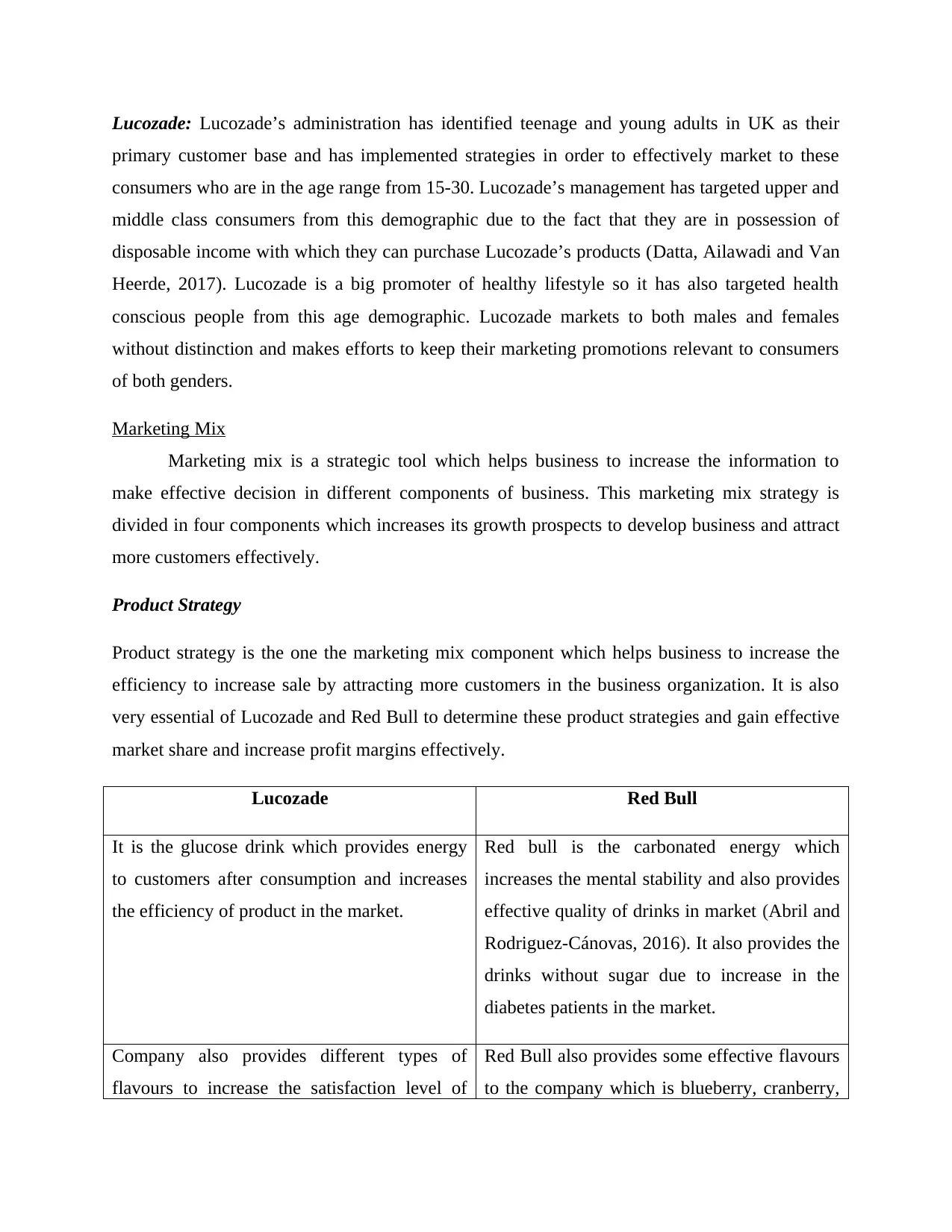
Lucozade: Lucozade’s administration has identified teenage and young adults in UK as their
primary customer base and has implemented strategies in order to effectively market to these
consumers who are in the age range from 15-30. Lucozade’s management has targeted upper and
middle class consumers from this demographic due to the fact that they are in possession of
disposable income with which they can purchase Lucozade’s products (Datta, Ailawadi and Van
Heerde, 2017). Lucozade is a big promoter of healthy lifestyle so it has also targeted health
conscious people from this age demographic. Lucozade markets to both males and females
without distinction and makes efforts to keep their marketing promotions relevant to consumers
of both genders.
Marketing Mix
Marketing mix is a strategic tool which helps business to increase the information to
make effective decision in different components of business. This marketing mix strategy is
divided in four components which increases its growth prospects to develop business and attract
more customers effectively.
Product Strategy
Product strategy is the one the marketing mix component which helps business to increase the
efficiency to increase sale by attracting more customers in the business organization. It is also
very essential of Lucozade and Red Bull to determine these product strategies and gain effective
market share and increase profit margins effectively.
Lucozade Red Bull
It is the glucose drink which provides energy
to customers after consumption and increases
the efficiency of product in the market.
Red bull is the carbonated energy which
increases the mental stability and also provides
effective quality of drinks in market (Abril and
Rodriguez-Cánovas, 2016). It also provides the
drinks without sugar due to increase in the
diabetes patients in the market.
Company also provides different types of
flavours to increase the satisfaction level of
Red Bull also provides some effective flavours
to the company which is blueberry, cranberry,
primary customer base and has implemented strategies in order to effectively market to these
consumers who are in the age range from 15-30. Lucozade’s management has targeted upper and
middle class consumers from this demographic due to the fact that they are in possession of
disposable income with which they can purchase Lucozade’s products (Datta, Ailawadi and Van
Heerde, 2017). Lucozade is a big promoter of healthy lifestyle so it has also targeted health
conscious people from this age demographic. Lucozade markets to both males and females
without distinction and makes efforts to keep their marketing promotions relevant to consumers
of both genders.
Marketing Mix
Marketing mix is a strategic tool which helps business to increase the information to
make effective decision in different components of business. This marketing mix strategy is
divided in four components which increases its growth prospects to develop business and attract
more customers effectively.
Product Strategy
Product strategy is the one the marketing mix component which helps business to increase the
efficiency to increase sale by attracting more customers in the business organization. It is also
very essential of Lucozade and Red Bull to determine these product strategies and gain effective
market share and increase profit margins effectively.
Lucozade Red Bull
It is the glucose drink which provides energy
to customers after consumption and increases
the efficiency of product in the market.
Red bull is the carbonated energy which
increases the mental stability and also provides
effective quality of drinks in market (Abril and
Rodriguez-Cánovas, 2016). It also provides the
drinks without sugar due to increase in the
diabetes patients in the market.
Company also provides different types of
flavours to increase the satisfaction level of
Red Bull also provides some effective flavours
to the company which is blueberry, cranberry,
Paraphrase This Document
Need a fresh take? Get an instant paraphrase of this document with our AI Paraphraser
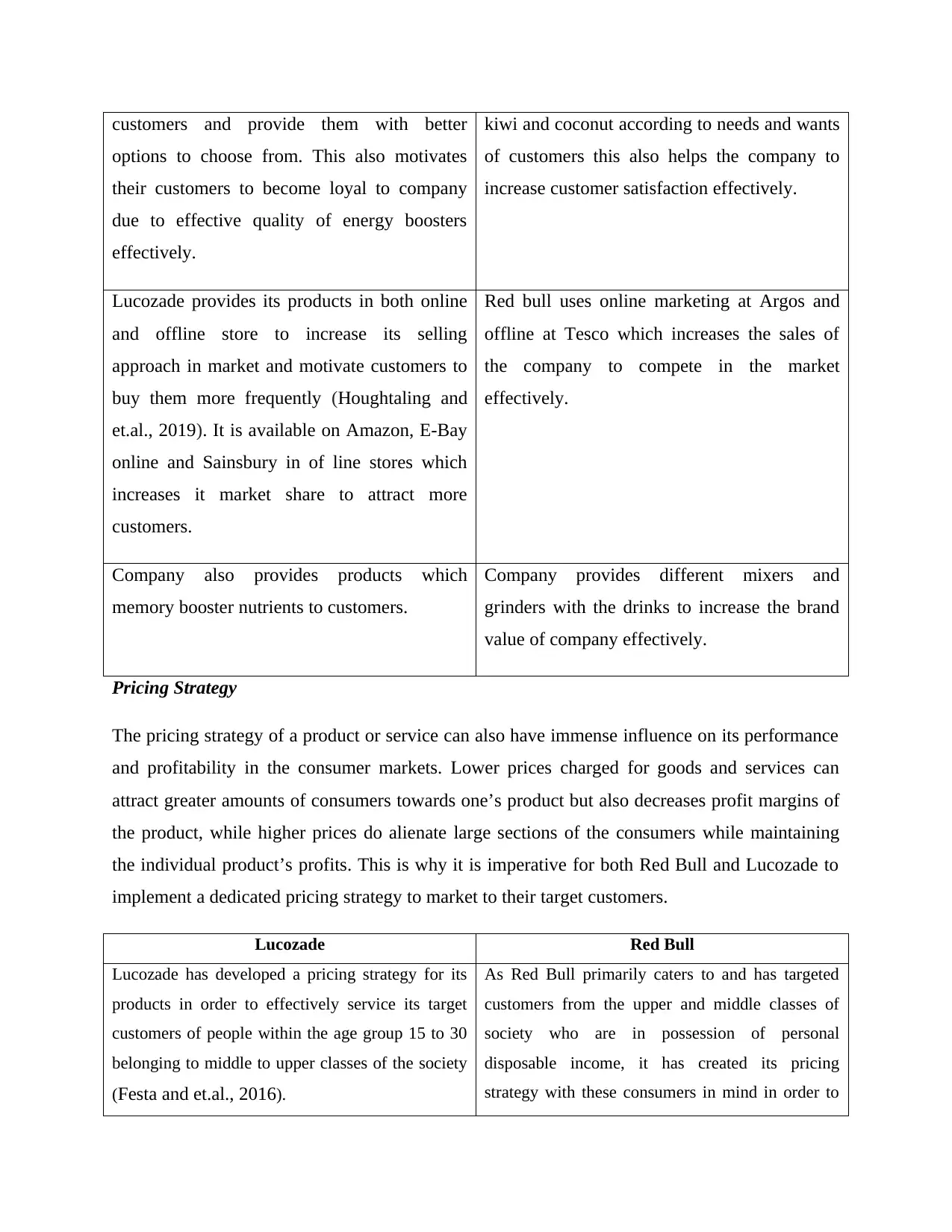
customers and provide them with better
options to choose from. This also motivates
their customers to become loyal to company
due to effective quality of energy boosters
effectively.
kiwi and coconut according to needs and wants
of customers this also helps the company to
increase customer satisfaction effectively.
Lucozade provides its products in both online
and offline store to increase its selling
approach in market and motivate customers to
buy them more frequently (Houghtaling and
et.al., 2019). It is available on Amazon, E-Bay
online and Sainsbury in of line stores which
increases it market share to attract more
customers.
Red bull uses online marketing at Argos and
offline at Tesco which increases the sales of
the company to compete in the market
effectively.
Company also provides products which
memory booster nutrients to customers.
Company provides different mixers and
grinders with the drinks to increase the brand
value of company effectively.
Pricing Strategy
The pricing strategy of a product or service can also have immense influence on its performance
and profitability in the consumer markets. Lower prices charged for goods and services can
attract greater amounts of consumers towards one’s product but also decreases profit margins of
the product, while higher prices do alienate large sections of the consumers while maintaining
the individual product’s profits. This is why it is imperative for both Red Bull and Lucozade to
implement a dedicated pricing strategy to market to their target customers.
Lucozade Red Bull
Lucozade has developed a pricing strategy for its
products in order to effectively service its target
customers of people within the age group 15 to 30
belonging to middle to upper classes of the society
(Festa and et.al., 2016).
As Red Bull primarily caters to and has targeted
customers from the upper and middle classes of
society who are in possession of personal
disposable income, it has created its pricing
strategy with these consumers in mind in order to
options to choose from. This also motivates
their customers to become loyal to company
due to effective quality of energy boosters
effectively.
kiwi and coconut according to needs and wants
of customers this also helps the company to
increase customer satisfaction effectively.
Lucozade provides its products in both online
and offline store to increase its selling
approach in market and motivate customers to
buy them more frequently (Houghtaling and
et.al., 2019). It is available on Amazon, E-Bay
online and Sainsbury in of line stores which
increases it market share to attract more
customers.
Red bull uses online marketing at Argos and
offline at Tesco which increases the sales of
the company to compete in the market
effectively.
Company also provides products which
memory booster nutrients to customers.
Company provides different mixers and
grinders with the drinks to increase the brand
value of company effectively.
Pricing Strategy
The pricing strategy of a product or service can also have immense influence on its performance
and profitability in the consumer markets. Lower prices charged for goods and services can
attract greater amounts of consumers towards one’s product but also decreases profit margins of
the product, while higher prices do alienate large sections of the consumers while maintaining
the individual product’s profits. This is why it is imperative for both Red Bull and Lucozade to
implement a dedicated pricing strategy to market to their target customers.
Lucozade Red Bull
Lucozade has developed a pricing strategy for its
products in order to effectively service its target
customers of people within the age group 15 to 30
belonging to middle to upper classes of the society
(Festa and et.al., 2016).
As Red Bull primarily caters to and has targeted
customers from the upper and middle classes of
society who are in possession of personal
disposable income, it has created its pricing
strategy with these consumers in mind in order to
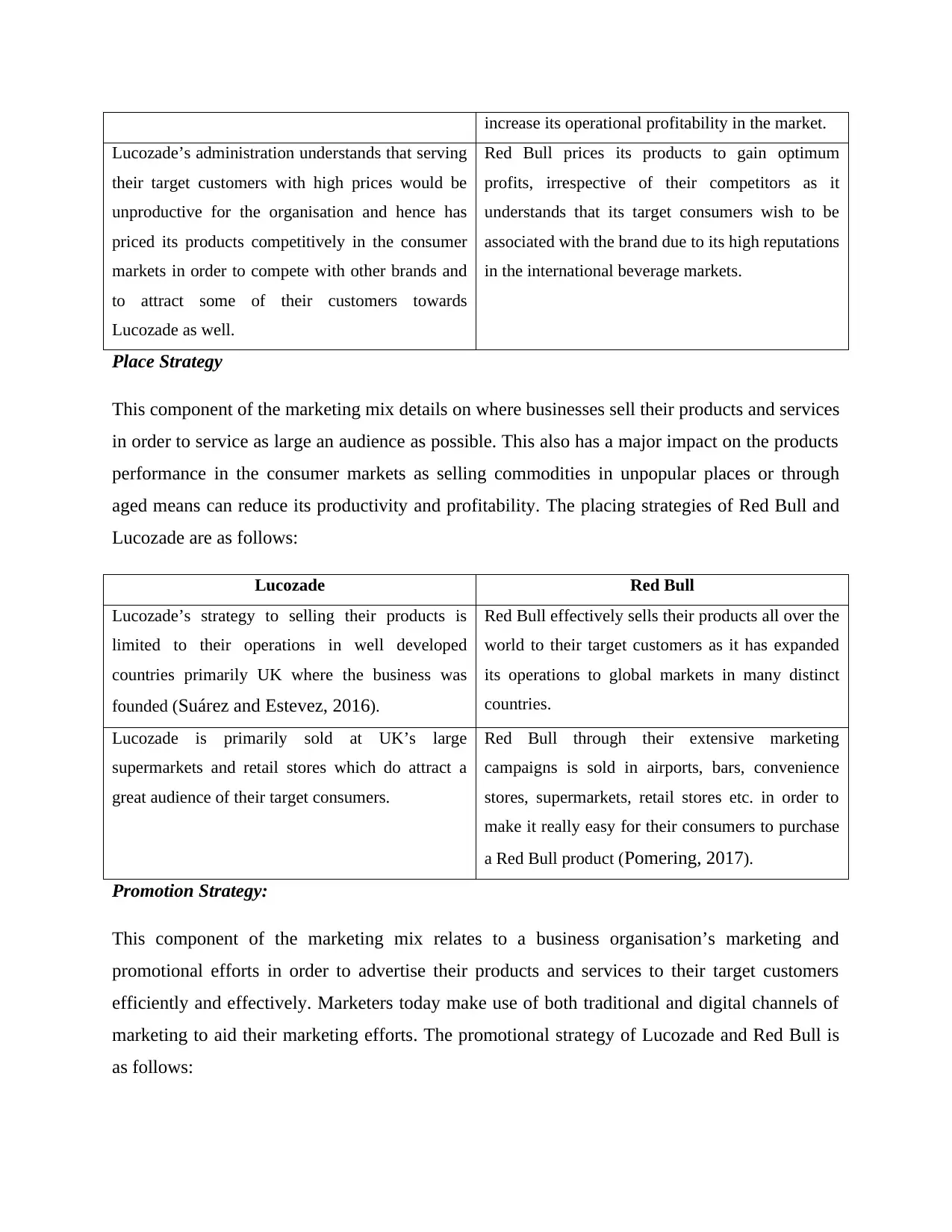
increase its operational profitability in the market.
Lucozade’s administration understands that serving
their target customers with high prices would be
unproductive for the organisation and hence has
priced its products competitively in the consumer
markets in order to compete with other brands and
to attract some of their customers towards
Lucozade as well.
Red Bull prices its products to gain optimum
profits, irrespective of their competitors as it
understands that its target consumers wish to be
associated with the brand due to its high reputations
in the international beverage markets.
Place Strategy
This component of the marketing mix details on where businesses sell their products and services
in order to service as large an audience as possible. This also has a major impact on the products
performance in the consumer markets as selling commodities in unpopular places or through
aged means can reduce its productivity and profitability. The placing strategies of Red Bull and
Lucozade are as follows:
Lucozade Red Bull
Lucozade’s strategy to selling their products is
limited to their operations in well developed
countries primarily UK where the business was
founded (Suárez and Estevez, 2016).
Red Bull effectively sells their products all over the
world to their target customers as it has expanded
its operations to global markets in many distinct
countries.
Lucozade is primarily sold at UK’s large
supermarkets and retail stores which do attract a
great audience of their target consumers.
Red Bull through their extensive marketing
campaigns is sold in airports, bars, convenience
stores, supermarkets, retail stores etc. in order to
make it really easy for their consumers to purchase
a Red Bull product (Pomering, 2017).
Promotion Strategy:
This component of the marketing mix relates to a business organisation’s marketing and
promotional efforts in order to advertise their products and services to their target customers
efficiently and effectively. Marketers today make use of both traditional and digital channels of
marketing to aid their marketing efforts. The promotional strategy of Lucozade and Red Bull is
as follows:
Lucozade’s administration understands that serving
their target customers with high prices would be
unproductive for the organisation and hence has
priced its products competitively in the consumer
markets in order to compete with other brands and
to attract some of their customers towards
Lucozade as well.
Red Bull prices its products to gain optimum
profits, irrespective of their competitors as it
understands that its target consumers wish to be
associated with the brand due to its high reputations
in the international beverage markets.
Place Strategy
This component of the marketing mix details on where businesses sell their products and services
in order to service as large an audience as possible. This also has a major impact on the products
performance in the consumer markets as selling commodities in unpopular places or through
aged means can reduce its productivity and profitability. The placing strategies of Red Bull and
Lucozade are as follows:
Lucozade Red Bull
Lucozade’s strategy to selling their products is
limited to their operations in well developed
countries primarily UK where the business was
founded (Suárez and Estevez, 2016).
Red Bull effectively sells their products all over the
world to their target customers as it has expanded
its operations to global markets in many distinct
countries.
Lucozade is primarily sold at UK’s large
supermarkets and retail stores which do attract a
great audience of their target consumers.
Red Bull through their extensive marketing
campaigns is sold in airports, bars, convenience
stores, supermarkets, retail stores etc. in order to
make it really easy for their consumers to purchase
a Red Bull product (Pomering, 2017).
Promotion Strategy:
This component of the marketing mix relates to a business organisation’s marketing and
promotional efforts in order to advertise their products and services to their target customers
efficiently and effectively. Marketers today make use of both traditional and digital channels of
marketing to aid their marketing efforts. The promotional strategy of Lucozade and Red Bull is
as follows:
⊘ This is a preview!⊘
Do you want full access?
Subscribe today to unlock all pages.

Trusted by 1+ million students worldwide
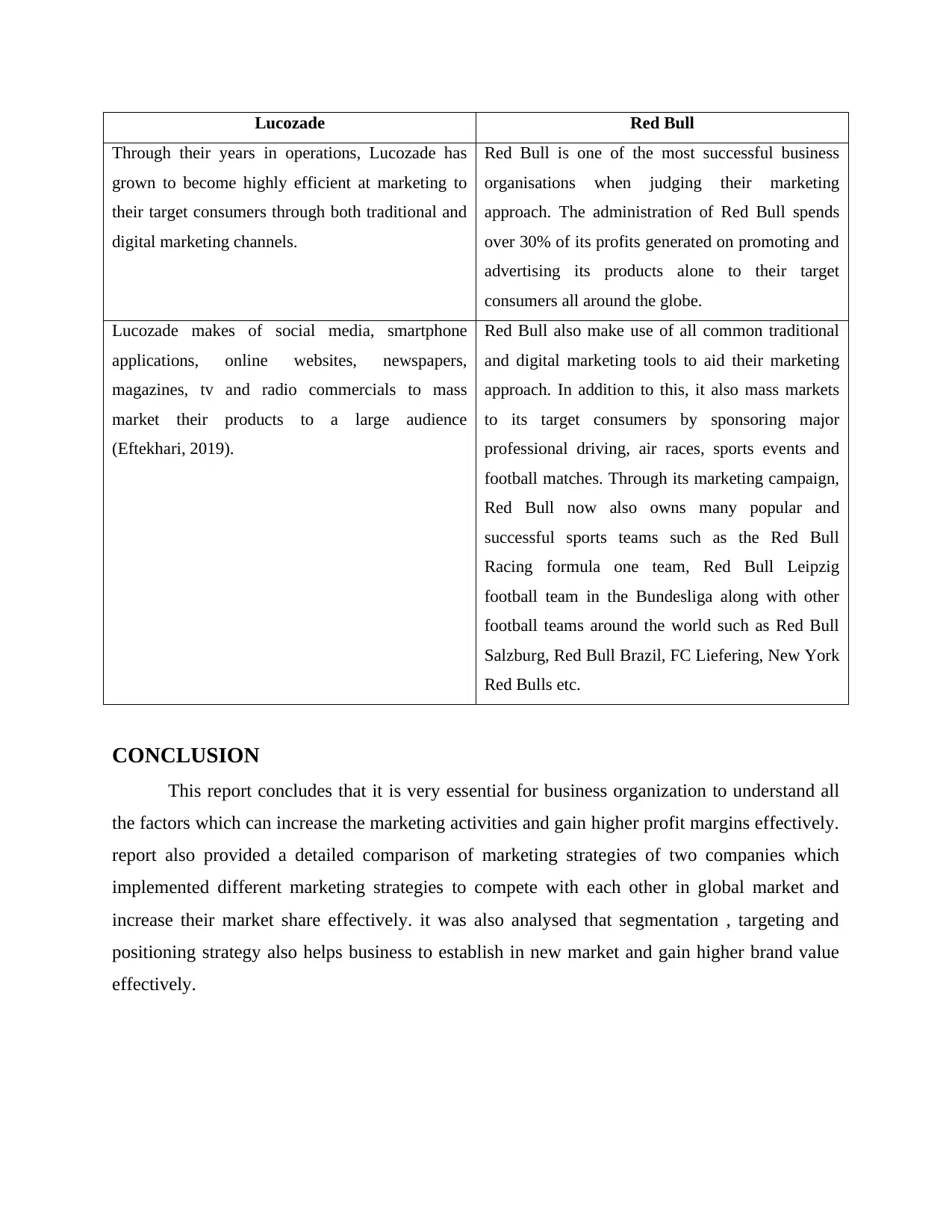
Lucozade Red Bull
Through their years in operations, Lucozade has
grown to become highly efficient at marketing to
their target consumers through both traditional and
digital marketing channels.
Red Bull is one of the most successful business
organisations when judging their marketing
approach. The administration of Red Bull spends
over 30% of its profits generated on promoting and
advertising its products alone to their target
consumers all around the globe.
Lucozade makes of social media, smartphone
applications, online websites, newspapers,
magazines, tv and radio commercials to mass
market their products to a large audience
(Eftekhari, 2019).
Red Bull also make use of all common traditional
and digital marketing tools to aid their marketing
approach. In addition to this, it also mass markets
to its target consumers by sponsoring major
professional driving, air races, sports events and
football matches. Through its marketing campaign,
Red Bull now also owns many popular and
successful sports teams such as the Red Bull
Racing formula one team, Red Bull Leipzig
football team in the Bundesliga along with other
football teams around the world such as Red Bull
Salzburg, Red Bull Brazil, FC Liefering, New York
Red Bulls etc.
CONCLUSION
This report concludes that it is very essential for business organization to understand all
the factors which can increase the marketing activities and gain higher profit margins effectively.
report also provided a detailed comparison of marketing strategies of two companies which
implemented different marketing strategies to compete with each other in global market and
increase their market share effectively. it was also analysed that segmentation , targeting and
positioning strategy also helps business to establish in new market and gain higher brand value
effectively.
Through their years in operations, Lucozade has
grown to become highly efficient at marketing to
their target consumers through both traditional and
digital marketing channels.
Red Bull is one of the most successful business
organisations when judging their marketing
approach. The administration of Red Bull spends
over 30% of its profits generated on promoting and
advertising its products alone to their target
consumers all around the globe.
Lucozade makes of social media, smartphone
applications, online websites, newspapers,
magazines, tv and radio commercials to mass
market their products to a large audience
(Eftekhari, 2019).
Red Bull also make use of all common traditional
and digital marketing tools to aid their marketing
approach. In addition to this, it also mass markets
to its target consumers by sponsoring major
professional driving, air races, sports events and
football matches. Through its marketing campaign,
Red Bull now also owns many popular and
successful sports teams such as the Red Bull
Racing formula one team, Red Bull Leipzig
football team in the Bundesliga along with other
football teams around the world such as Red Bull
Salzburg, Red Bull Brazil, FC Liefering, New York
Red Bulls etc.
CONCLUSION
This report concludes that it is very essential for business organization to understand all
the factors which can increase the marketing activities and gain higher profit margins effectively.
report also provided a detailed comparison of marketing strategies of two companies which
implemented different marketing strategies to compete with each other in global market and
increase their market share effectively. it was also analysed that segmentation , targeting and
positioning strategy also helps business to establish in new market and gain higher brand value
effectively.
Paraphrase This Document
Need a fresh take? Get an instant paraphrase of this document with our AI Paraphraser
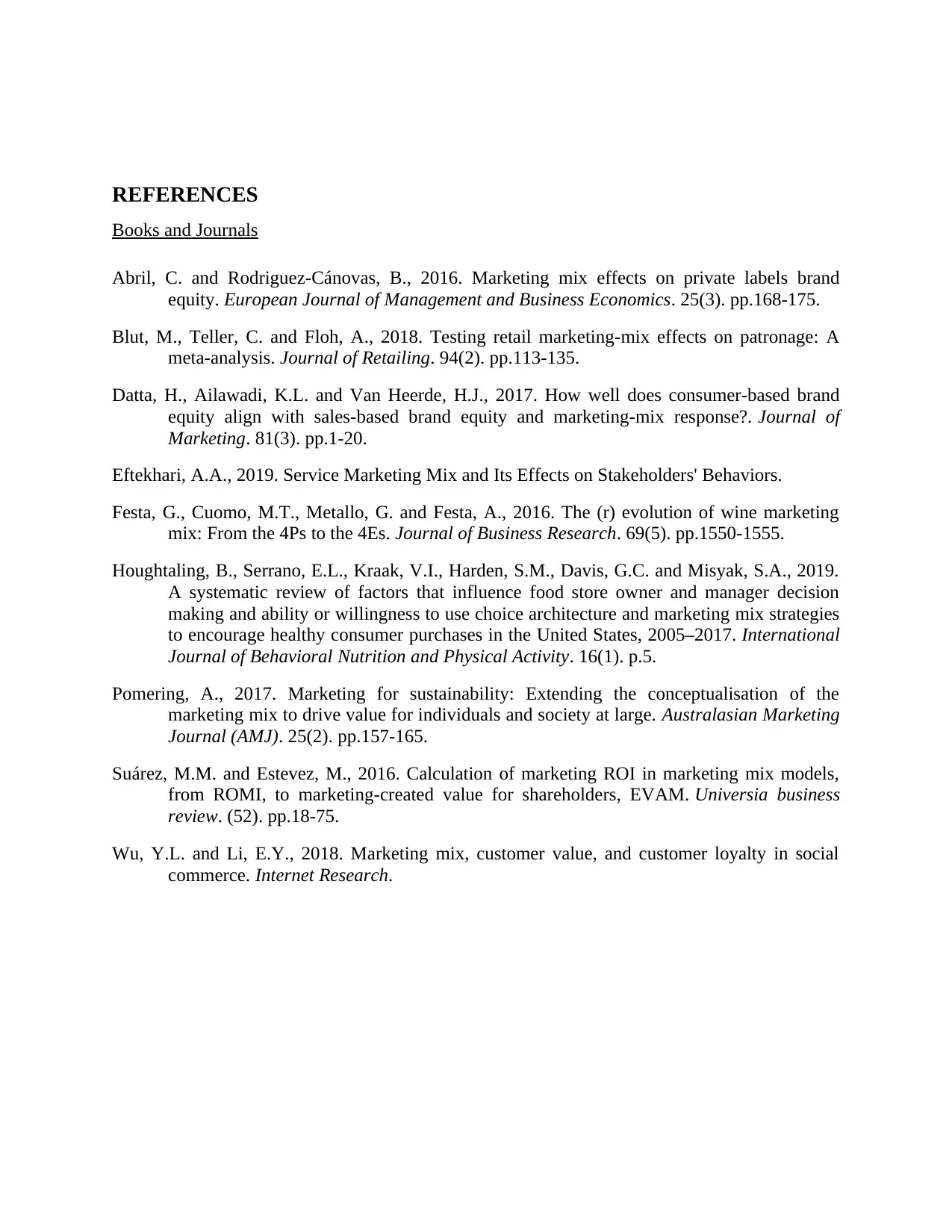
REFERENCES
Books and Journals
Abril, C. and Rodriguez-Cánovas, B., 2016. Marketing mix effects on private labels brand
equity. European Journal of Management and Business Economics. 25(3). pp.168-175.
Blut, M., Teller, C. and Floh, A., 2018. Testing retail marketing-mix effects on patronage: A
meta-analysis. Journal of Retailing. 94(2). pp.113-135.
Datta, H., Ailawadi, K.L. and Van Heerde, H.J., 2017. How well does consumer-based brand
equity align with sales-based brand equity and marketing-mix response?. Journal of
Marketing. 81(3). pp.1-20.
Eftekhari, A.A., 2019. Service Marketing Mix and Its Effects on Stakeholders' Behaviors.
Festa, G., Cuomo, M.T., Metallo, G. and Festa, A., 2016. The (r) evolution of wine marketing
mix: From the 4Ps to the 4Es. Journal of Business Research. 69(5). pp.1550-1555.
Houghtaling, B., Serrano, E.L., Kraak, V.I., Harden, S.M., Davis, G.C. and Misyak, S.A., 2019.
A systematic review of factors that influence food store owner and manager decision
making and ability or willingness to use choice architecture and marketing mix strategies
to encourage healthy consumer purchases in the United States, 2005–2017. International
Journal of Behavioral Nutrition and Physical Activity. 16(1). p.5.
Pomering, A., 2017. Marketing for sustainability: Extending the conceptualisation of the
marketing mix to drive value for individuals and society at large. Australasian Marketing
Journal (AMJ). 25(2). pp.157-165.
Suárez, M.M. and Estevez, M., 2016. Calculation of marketing ROI in marketing mix models,
from ROMI, to marketing-created value for shareholders, EVAM. Universia business
review. (52). pp.18-75.
Wu, Y.L. and Li, E.Y., 2018. Marketing mix, customer value, and customer loyalty in social
commerce. Internet Research.
Books and Journals
Abril, C. and Rodriguez-Cánovas, B., 2016. Marketing mix effects on private labels brand
equity. European Journal of Management and Business Economics. 25(3). pp.168-175.
Blut, M., Teller, C. and Floh, A., 2018. Testing retail marketing-mix effects on patronage: A
meta-analysis. Journal of Retailing. 94(2). pp.113-135.
Datta, H., Ailawadi, K.L. and Van Heerde, H.J., 2017. How well does consumer-based brand
equity align with sales-based brand equity and marketing-mix response?. Journal of
Marketing. 81(3). pp.1-20.
Eftekhari, A.A., 2019. Service Marketing Mix and Its Effects on Stakeholders' Behaviors.
Festa, G., Cuomo, M.T., Metallo, G. and Festa, A., 2016. The (r) evolution of wine marketing
mix: From the 4Ps to the 4Es. Journal of Business Research. 69(5). pp.1550-1555.
Houghtaling, B., Serrano, E.L., Kraak, V.I., Harden, S.M., Davis, G.C. and Misyak, S.A., 2019.
A systematic review of factors that influence food store owner and manager decision
making and ability or willingness to use choice architecture and marketing mix strategies
to encourage healthy consumer purchases in the United States, 2005–2017. International
Journal of Behavioral Nutrition and Physical Activity. 16(1). p.5.
Pomering, A., 2017. Marketing for sustainability: Extending the conceptualisation of the
marketing mix to drive value for individuals and society at large. Australasian Marketing
Journal (AMJ). 25(2). pp.157-165.
Suárez, M.M. and Estevez, M., 2016. Calculation of marketing ROI in marketing mix models,
from ROMI, to marketing-created value for shareholders, EVAM. Universia business
review. (52). pp.18-75.
Wu, Y.L. and Li, E.Y., 2018. Marketing mix, customer value, and customer loyalty in social
commerce. Internet Research.
1 out of 8
Related Documents
Your All-in-One AI-Powered Toolkit for Academic Success.
+13062052269
info@desklib.com
Available 24*7 on WhatsApp / Email
![[object Object]](/_next/static/media/star-bottom.7253800d.svg)
Unlock your academic potential
Copyright © 2020–2025 A2Z Services. All Rights Reserved. Developed and managed by ZUCOL.





